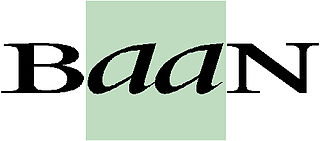
Enterprise resource planning (ERP) is the integrated management of main business processes, often in real time and mediated by software and technology. ERP is usually referred to as a category of business management software—typically a suite of integrated applications—that an organization can use to collect, store, manage and interpret data from many business activities. ERP systems can be local based or cloud-based. Cloud-based applications have grown in recent years due to information being readily available from any location with Internet access. Traditional on-premises ERP systems are now considered legacy technology.
Zope is a family of free and open-source web application servers written in Python, and their associated online community. Zope stands for "Z Object Publishing Environment", and was the first system using the now common object publishing methodology for the Web. Zope has been called a Python killer app, an application that helped put Python in the spotlight.
A management information system (MIS) is an information system used for decision-making, and for the coordination, control, analysis, and visualization of information in an organization. The study of the management information systems involves people, processes and technology in an organizational context.

Baan was a vendor of enterprise resource planning (ERP) software that is now owned by Infor Global Solutions. Baan or Baan ERP, was also the name of the ERP product created by this company.
Information technology (IT)governance is a subset discipline of corporate governance, focused on information technology (IT) and its performance and risk management. The interest in IT governance is due to the ongoing need within organizations to focus value creation efforts on an organization's strategic objectives and to better manage the performance of those responsible for creating this value in the best interest of all stakeholders. It has evolved from The Principles of Scientific Management, Total Quality Management and ISO 9001 Quality management system.
Enterprise application integration (EAI) is the use of software and computer systems' architectural principles to integrate a set of enterprise computer applications.
A product software implementation method is a systematically structured approach to effectively integrate a software based service or component into the workflow of an organizational structure or an individual end-user.

Computer-integrated manufacturing (CIM) is the manufacturing approach of using computers to control the entire production process. This integration allows individual processes to exchange information with each part. Manufacturing can be faster and less error-prone by the integration of computers. Typically CIM relies on closed-loop control processes based on real-time input from sensors. It is also known as flexible design and manufacturing.
Big bang adoption or direct changeover is when a new system is adopted instantly, with no transition period between the old and new systems.

SAP ERP is an enterprise resource planning software developed by the German company SAP SE. SAP ERP incorporates the key business functions of an organization. The latest version of SAP ERP (V.6.0) was made available in 2006. The most recent SAP enhancement package 8 for SAP ERP 6.0 was released in 2016. It is now considered legacy technology, having been superseded by SAP S/4HANA.
Business process management (BPM) is the discipline in which people use various methods to discover, model, analyze, measure, improve, optimize, and automate business processes. Any combination of methods used to manage a company's business processes is BPM. Processes can be structured and repeatable or unstructured and variable. Though not required, enabling technologies are often used with BPM.
SAP implementation refers to the name of the German company SAP SE, and is the whole of processes that defines a method to implement the SAP ERP enterprise resource planning software in an organization. The SAP implementation method described in this entry is a generic method and not a specific implementation method as such. It is based on best practices and case studies from various literature sources and presents a collection of processes and products that make up a complete implementation method to allow any organization to plan and execute the implementation of SAP software.

ERPNext is a free and open-source integrated Enterprise Resource Planning (ERP) software developed by an Indian software company Frappe Technologies Pvt. Ltd. and is built on MariaDB database system using Frappe, a Python based server-side framework.

iDempiere. Community Powered Enterprise, also known as OSGi + ADempiere, is an open source Enterprise Resource Planning (ERP) software that is fully navigable on PCs, tablets and smartphones, it also has customer relationship management (CRM) and supply chain management (SCM) functions. It is in contrast to proprietary or most other open source ERP solutions driven only by a community of supporters.
Phalcon is a PHP web framework based on the model–view–controller (MVC) pattern. Originally released in 2012, it is an open-source framework licensed under the terms of the BSD License.

Odoo is a Belgian suite of business management software tools including, for example, CRM, e-commerce, billing, accounting, manufacturing, warehouse, project management, and inventory management.

SAP S/4HANA is an enterprise resource planning software for large enterprises developed by SAP SE. It is the successor to SAP R/3 and SAP ERP and is optimized for SAP's in-memory database SAP HANA.
Microsoft Dynamics 365 is a product line of enterprise resource planning (ERP) and customer relationship management (CRM) intelligent business applications announced by Microsoft in July 2016 and released on November 1, 2016. It was formerly Microsoft Dynamics.
metasfresh is an open source/free ERP software designed and developed for SMEs. metasfresh is an actively maintained fork of ADempiere and can be used and distributed freely. It does not require a contributor license agreement from partners or contributors. There is no closed source code, and the planning and development happen openly in the community. metasfresh was included in the Top 9 Open Source ERP to consider by opensource.com.






